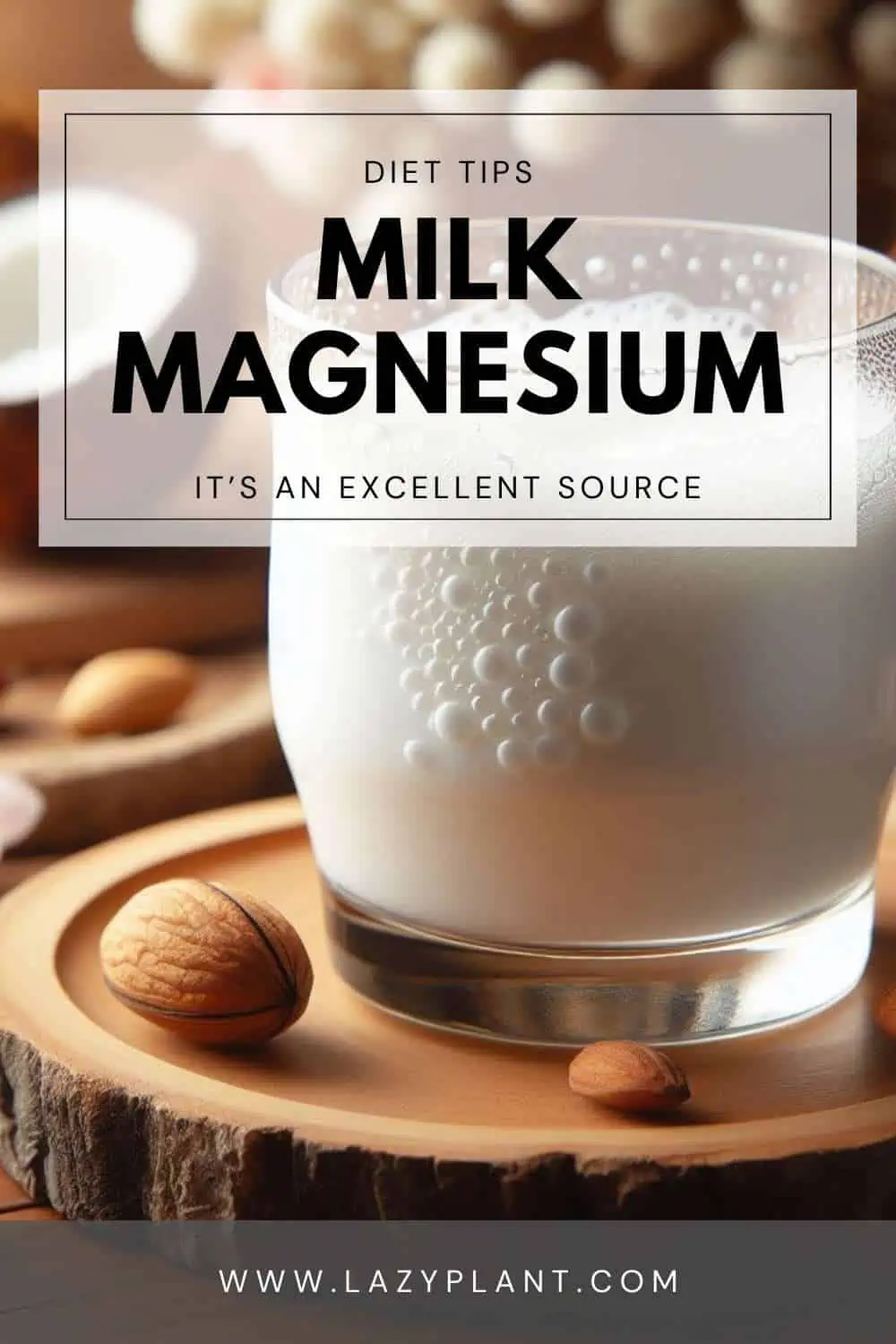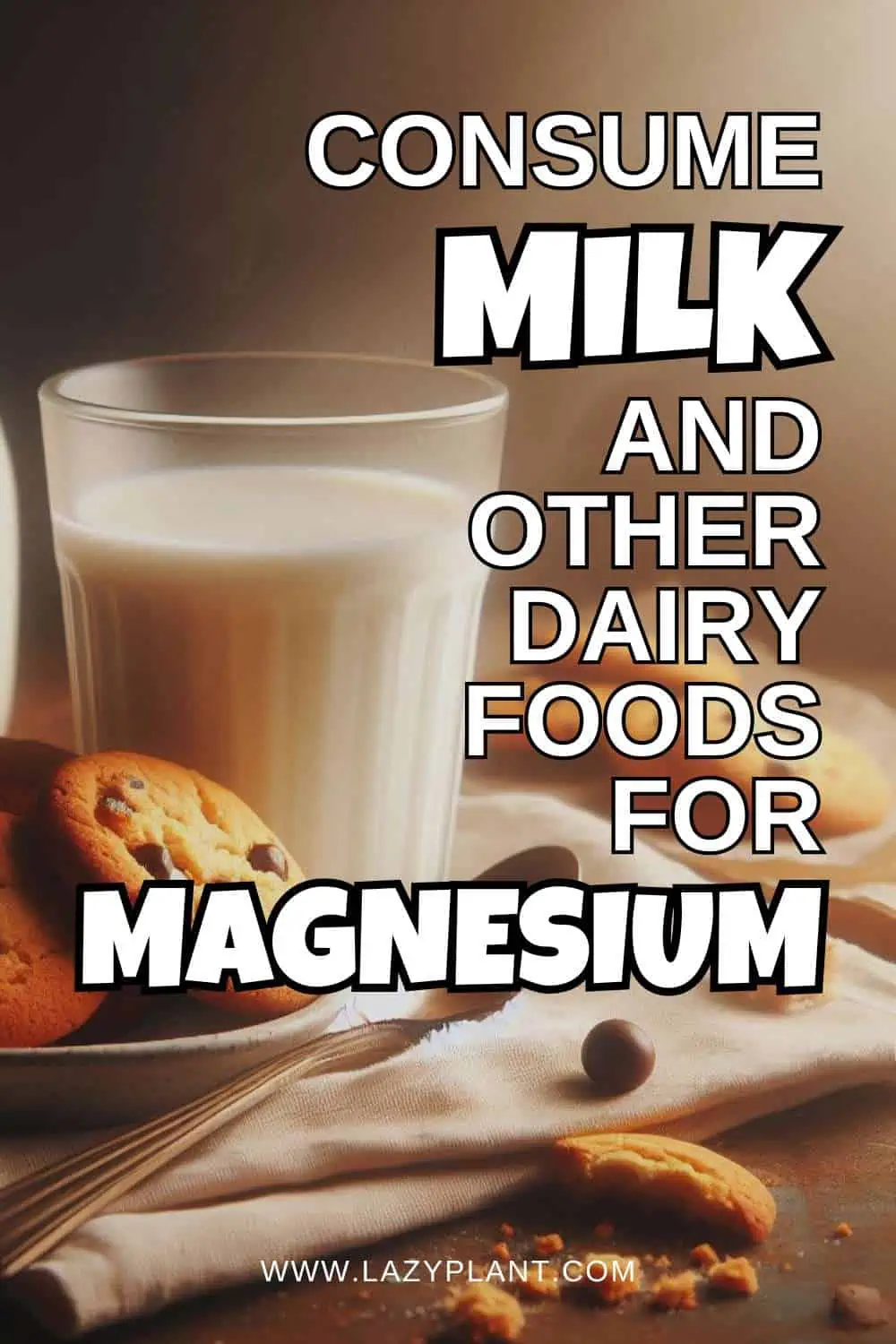Cow’s milk as well as plant-based milks and yogurt are rich in magnesium. They provide 4-7% of the recommended daily intake per serving! Cheese can’t help us meet our daily needs for magnesium, though, as most cheeses provide less than 2% of the DV per serving.
Is cow’s milk rich in magnesium?
Cow’s milk is a good dietary source of magnesium. It has approximately 12 mg of magnesium per 100g. A glass of cow’s milk has about 30 mg of magnesium. This dose is 7% of the Daily Value (DV). Low-fat milk has a similar magnesium content to whole milk.
Cow’s milk isn’t the only milk high in magnesium, though. Many other animal-derived milks contain high amounts of magnesium. For instance, goat’s milk has a similar magnesium content to cow’s milk. A glass also provides 7% of the DV.

What’s the magnesium content of dairy products?
Besides cow’s milk, only yogurt is rich in magnesium. Whole yogurt, low-fat yogurt, and Greek yogurt have a similar magnesium content. In fact, yogurt has approximately 11 mg of magnesium per 100g or 17 mg of magnesium per serving. A container provides approximately 4% of the DV.
On the contrary, although, cow’s milk is rich in magnesium, cheese isn’t a good dietary source of magnesium. All common cheeses contain less magnesium than 3% of the required daily intake per serving!
Actually, the only cheeses providing more magnesium than 2% of the DV per serving are Parmesan. Edam, brie, and Gouda. Parmesan is the richest cheese in magnesium, containing 9.9 mg per serving, which is 2.4% of the DV.
| magnesium (mg) per 100g | magnesium (mg) per 1 oz | % DV | |
| Parmesan | 35 | 9.9 | 2.4% |
| Edam | 30 | 8.5 | 2% |
| brie | 30 | 8.5 | 2% |
| Gouda | 29 | 8.2 | 2% |
| provolone | 28 | 7.9 | 1.9% |
| mozzarella | 27.2 | 7.7 | 1.8% |
| cheddar | 26.8 | 7.6 | 1.8% |
| blue cheese | 23 | 6.5 | 1.6% |
| ricotta | 19.7 | 5.6 | 1.3% |
| feta | 19 | 5.4 | 1.3% |
| cottage cheese | 8.9 | 2.5 | 0.6% |
| heavy cream | 7 | 2 | 0.5% |
| spread cheese | 6 | 1.7 | 0.4% |
Don’t eat Cheese for Magnesium
Thus, we can’t depend on cheese to get the required daily dose of magnesium. Most noteworthy, cheese is particularly high in saturated fat. Most cheeses have about 5 grams of saturated fat per 1 oz. This amount is 40% of the maximum safe intake!
According to the American Heart Association, we shouldn’t consume more than 13 grams of saturated fatty acids per 2,000 calories. Eating high amounts of saturated fat can raise LDL cholesterol. A high level of LDL cholesterol increases the risk of heart disease and stroke.[2]
Furthermore, butter contains negligible amounts of magnesium. Butter contains only 2 mg of magnesium per 100g. We should eat butter in moderation, as it’s mainly fat. A tbsp has 7.2 grams of saturated fat.
Do plant-based milks have more magnesium than cow’s milk?
Most plant-based milks are high in magnesium as well. Soy milk is the richest plant-based milk in magnesium. A glass of soy milk provides up to 9% of the Daily Value. Rice, almond, and oat milk are also good dietary sources of magnesium.
Actually, almonds are the richest nuts and one of the richest foods in magnesium.
| magnesium (mg) per 100 mL | magnesium (mg) per glass | % DV | |
| soy milk | 15 | 38 | 9% |
| rice milk | 11 | 28 | 7% |
| almond milk | 7 | 17 | 4% |
| oat milk | 6 | 15 | 4% |
| coconut milk | 0 | 0 | 0% |
You can find a wide variety of plant-based milks on Amazon.
Do we absorb the magnesium in milk & dairy?
It’s estimated that we absorb 30-50% of the magnesium in food. The absorption rate depends on the consumed dose. We tend to absorb less magnesium when we get higher doses.[3]
What’s the recommended daily intake?
The recommended daily intake of magnesium is approximately 400-420 mg for adult men and 310-320 mg for adult women. Teenagers and pregnant women have high magnesium needs (360-410 mg) as well. Children require lower dosages.[4]
Can dairy help us meet our daily needs?
Certainly, milk and yogurt can help us meet our daily magnesium needs. They have a moderate magnesium content, as a serving provides 4-7% of the DV.
On the contrary, cheese is poor in magnesium. Better eat cheese in moderation, as it’s high in calories, sodium, saturated fats, and even trans fats!
Can we get too much magnesium from milk?
Healthy people can’t get too much magnesium from milk or dairy. The kidneys eliminate excess amounts in the urine. However, patients with impaired renal function or kidney failure can get too much magnesium from a diet. In certain diseases, the kidneys can’t remove excess magnesium.
How to increase the absorption rate of magnesium in milk?
Actually, many factors might inhibit the absorption rate of magnesium in milk and other dairy.
Above all, we should have normal vitamin D levels for optimal magnesium absorption. Vitamin D stimulates intestinal magnesium absorption. However, as vitamin D deficiency is pretty common, many people would benefit from taking high doses of vitamin D from dietary supplements.[5]
Increased intakes of protein and fructose may improve magnesium absorption as well. Hence, you could add fruits to yogurt. Actually, bananas and avocados are the richest fruits in magnesium.[6]
What’s the calcium/magnesium ratio of milk?
Furthermore, we have to consume the recommended daily intake of calcium for better absorption of magnesium. Too little or too much calcium may negatively affect the absorption rate of magnesium. The calcium/magnesium ratio should be between 1.70 and 2.60.[7]
However, as milk is particularly rich in calcium, it has a pretty high calcium/magnesium ratio of 10. Thus, you should drink cow’s milk in moderation. Even plant-based milk has a high calcium/magnesium ratio, as they’re fortified with calcium!
Most noteworthy, a high calcium-to-magnesium ratio seems to be strongly associated with increased disease risk.[8]
Other common foods high in magnesium
Magnesium is naturally found in both animal (e.g. meat, fish, eggs) and plant-based foods, as well as certain beverages. Green leafy vegetables, legumes, beans, nuts, seeds, whole grains, and certain fruits are good sources of magnesium. In general, foods high in fiber are also high in magnesium.
Pumpkin seeds, chia seeds, almonds, and spinach are the richest common foods in magnesium. They provide 19-37% of the required daily intake per serving!

Whole grains have decent amounts of magnesium as well. Refined grains contain negligible amounts of magnesium, though. The removal of the nutrient-rich germ and bran substantially decreases the magnesium content of the grain.
In addition, tap, mineral, and bottled water can be good sources of magnesium. However, the amount of magnesium in water significantly varies. It ranges from 1 mg per liter to more than 120 mg per liter!
Certainly, following a well-balanced, plant-based diet can provide more than enough magnesium.
However, dietary surveys in the United States consistently show that many people consume less than the recommended daily intake of magnesium.
You can boost your daily magnesium intake with dietary supplements. You can find a wide variety of magnesium supplements on iHerb.
Always consult your physician before changing your diet or taking dietary supplements.
Recipe Ideas to skyrocket your Magnesium intake
Boosting your daily magnesium intake is easy. Here you’ll find 10 creative and easy recipe ideas with milk, yogurt, or cottage cheese that can help you meet your daily needs.
- Milk and banana smoothie bowl (~15% DV per serving): 1 cup milk, 1 banana (27 mg/100g), 1 tablespoon chia seeds (335 mg/100g).
- Greek yogurt parfait (~20% DV per serving): 1 cup Greek yogurt, mixed berries, 1 tablespoon pumpkin seeds (262 mg/100g).
- Spinach and feta stuffed crêpes (~25% DV per serving): Crêpes, spinach (79 mg/100g), feta cheese (19 mg/100g).
- Ricotta and berry toast (~22% DV per serving): Whole grain toast, ricotta cheese (32 mg/100g), mixed berries.
- Blueberry yogurt smoothie (~18% DV per serving): Blueberries, plain yogurt, honey.
- Sunflower seed yogurt bowl (~26% DV per serving): Greek yogurt, sunflower seeds (325 mg/100g), sliced peaches.
- Pumpkin spice latte with milk (~18% DV per serving): Milk, espresso, pumpkin spice (63 mg/100g).
Vegan Recipe Ideas
- Chocolate avocado pudding with almond milk (~12% DV per serving): Almond milk, avocado, cocoa powder.
- Quinoa porridge with almond milk (~30% DV per serving): Quinoa (197 mg/100g), almond milk, sliced kiwi.
- Almond butter and banana wrap (~24% DV per serving): Whole grain wrap, almond butter (76 mg/100g), sliced bananas.
Magnesium content may vary based on specific brands and varieties of ingredients. Always check nutritional labels for accurate values.
Benefits of Magnesium for Weight Loss
Magnesium is an essential mineral that plays a variety of roles in the body, and while it doesn’t directly cause weight loss, it can offer some benefits that might indirectly support your weight loss efforts.
Magnesium may help your body use insulin more effectively, leading to better blood sugar regulation. This can be beneficial for weight loss as uncontrolled blood sugar fluctuations can increase cravings and hunger.
Also, magnesium is involved in activating enzymes that help your body convert food into energy. This can potentially improve your metabolism and increase calorie burning at rest.
Moreover, magnesium plays a role in stress management. Studies suggest that adequate magnesium levels might help regulate stress hormones like cortisol, which can contribute to cravings and emotional eating.
Magnesium deficiency is linked to sleep disturbances. Getting enough sleep is crucial for regulating hormones that influence appetite and metabolism. Better sleep quality with adequate magnesium intake might indirectly support weight loss.
Chronic magnesium deficiency is sometimes linked to insulin resistance, a condition that can hinder weight loss efforts. Ensuring adequate magnesium intake might help prevent this.
However, dairy products support weight loss directly and indirectly in many ways, with kefir being the healthiest food option.